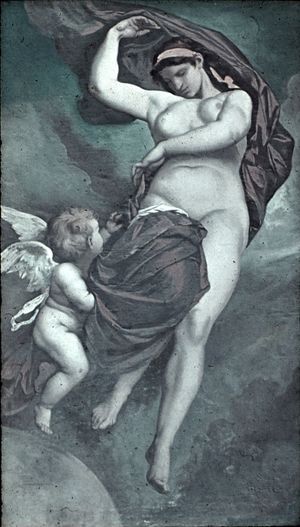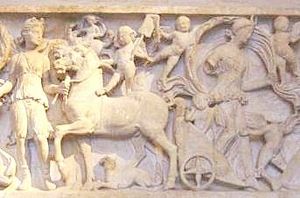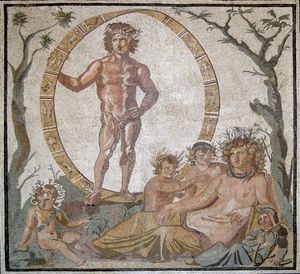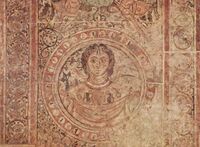گايا (أسطورة)
| Gaia | |
|---|---|
Personification of the Earth | |
 Anselm Feuerbach: Gaea (1875). Ceiling painting, Academy of Fine Arts Vienna | |
| أسماء أخرى | Ge Gaea |
| Greek | Γαῖα, Γῆ |
| الأبوان | None (Hesiod)[1] |
| القرين | Uranus, Pontus, Tartarus |
| الأنجال | Uranus, Pontus, the Ourea, the Hecatonchires, the Cyclopes, the Titans, the Gigantes, Nereus, Thaumus, Phorcys, Ceto, Eurybia, Typhon |
| الآلهة المكافئة | |
| المكافئ الروماني | Terra |
| المكافئ النورسي | Jörð |
| مذاهب أساسية | |
| تعدد الآلهة · الأساطير · Hubris Orthopraxy · Reciprocity · الفضيلة | |
| الطقوس | |
|
أمفيدروميا · ياترومانتس | |
| آلهة | |
| الاولمپيون الاثنى عشر: آرس · أرتميس · أفروديت · أبولو أثينا · دميتر · هيرا · هستيا هرمس · هفستس · پوسايدون · زيوس --- الآلهة الأزلية: Aether · كاوس · خرونوس · إربوس گايا · همرا · نيكس · ترتاروس · أورانوس --- الآلهة الأصغر: ديونيسس · إروس · هبه · Hecate · هليوس هراقليس · إيريس · سلنه · پان · Nike | |
| نصوص | |
| Argonautica · إلياذة · اوديسة Theogony · الأعمال والأيام | |
| انظر أيضا: | |
| انزواء الشرك الهليني Hellenic Polytheistic Reconstructionism Supreme Council of Ethnikoi Hellenes |
| سلسلة الآلهة اليونانية |
|---|
| الآلهة الأزلية |
گايا Gaea أو Ge أو Gaia، وباليونانية (Γαῖα)، من شخصيات الميثولوجيا الإغريقية، الأم الارض. تطابق في الميثولوجيا الرومانية الإلهة تِرّا (Terra). Gaia is the ancestral mother—sometimes parthenogenic—of all life. She is the mother of Uranus (Sky), from whose sexual union she bore the Titans (themselves parents of many of the Olympian gods), the Cyclopes, and the Giants; as well as of Pontus (Sea), from whose union she bore the primordial sea gods. Her equivalent in the Roman pantheon was Terra.[2]
أصل الاسم
The Greek name Γαῖα (Gaia grc or [ɡâj.ja]) is a mostly epic, collateral form of Attic Γῆ (Gē [ɡɛ̂ː]), and Doric Γᾶ (Ga [ɡâː]),[3] perhaps identical to Δᾶ (Da [dâː]),[4] both meaning "Earth". The word is of uncertain origin.[5] Beekes suggested a Pre-Greek origin.[6]
In Mycenean Greek Ma-ka (transliterated as Ma-ga, "Mother Gaia") also contains the root ga-.[6][7]
الأسطورة
نسبها وذريتها
وفقاً للأساطير اليونانية القديمة للخلق، فإن گايا هي ابنة كاوس، الإله الأول والأقدم ممثلاً الفراغ البدائي الذي نشأ كل شيء منه. وهي تشخيص الأم الأرض، والتي ارتفعت منها السماء، وخُلقت منها الجبال والبحر (ممثلاً ربما بـ پونتوس Pontus)، وتشخيص السماء هو أورانوس ابن جايا وزوجها. وكثيرة هي ذرية جايا واورانوس، فمنها السيكلوبس (عمالقة بعين واحدة)، ومنها العمالقة، ومنها الـ Hecatoncheires، إلا أن أهم ذريتهما هي الجبابرة الاثنا عشر الأوائل، الذين لهم دور كبير في الميثولوجيا الإغريقية، وأهمهم كرونوس وريا. ومن أبنائها أيضاً بايثون، وهي أفعى عظيمة تكونت من الطين الباقي على الأرض بعد الطوفان الكبير. ومنها أيضاً الآلهة المنتقمة الثلاث (Erinyes) أو (Furies)، اللواتي تشكلن من دماء أورانوس التي سقطت على الأرض (راجع أورانوس. وأنتايوس، عملاق ليبيا القوي، ابنها من إله البحر بوزيدون. إلا أن آخر أبنائها وأكثرهم رعباً هو تايفون، ابنها من ترتاروس.
دورها في الميثولوجيا اليونانية

وفقاً للأساطير اليونانية، فإن اورانوس كان يكره ويخاف العمالقة رغم أنهم أبناؤه، فحبسهم في مكان سري داخل جسد جايا (كونها الأرض)، تاركاً السيكلوپس والجبابرة طلقاء. فأثار هذا التحيز والعنصرية حنق جايا، التي استنجدت بأبنائها الآخرين، إلا أن كرونوس (أحد الجبابرة وملكهم) وحده لباها، حيث أخصى أباه أورانوس حينما كان يقترب من جايا، فاصلاً بذلك بين الأرض (گايا) والسماء (أورانوس)، ومن دماء أورانوس التي سقطت على الأرض (جايا) تشكلت الآلهة المنتقمة الثلاث (وربما عمالقة آخرون). بينما تشكلت أفروديت من الزبد الأبيض الذي تشكل من بقايا الأعضاء التناسلية لاورانوس والتي تناثرت على البحر.
علاقتها بزيوس وهيرا
يوجد تشابه إلى حد ما بين هيرا وريا وگايا، فكل منهن اعتبرت أم الآلهة في فترة معينة، وقد كانت هنالك علاقات بينهن أيضاً، فقد أهدت جايا سليلتها هيرا في يوم زفافها الشجرة التي لها أغصان وأوراق ذهبية، والتي تحمل تفاحاً ذهبياً، والتي تحرسها الـ Hesperides بنات أطلس أحد الجبابرة.
ولگايا أيضاً صلة وثيقة بزيوس، فقد ساعدته في إجبار كرونوس على "تقيؤ" إخوته الخمسة والحجر الذي ابتلعه بدلاً منه، إضافة إلى أنها تُصوَّر عادة على أنها حاضرة في أثناء ولادة زيوس التي حصلت بشكل مكتوم (راجع ريا وزيوس)، إلا أنها في تظهر في بعض الأساطير كعدوة له لأنها أم العمالقة وتايفون والذين حاربهم أو قتلهم زيوس.
مكانتها وعبادتها

كانت جايا تصور على أنها معطية الأحلام ومغذية الأطفال والنباتات. وقد كانت تعبد أصلاً كأم للآلهة في اليونان قبل أن يدخل الإغريق في عبادة زيوس. إلا أنها عُبدت شكل أقل في الفترات المعروفة تاريخياً.
In ancient times, Gaia was mainly worshipped alongside Demeter and as a part of the cult of Demeter and does not seem to have had a separate cult. Being a chthonic deity, black animals were sacrificed to her:
[Sacrifices to the gods as witnesses of an oath:] Bring two lambs : let one be white and the other black for Gaia (Earth) and Helios (Sun). [N.B. Chthonic Gaia receives a black animal, celestial Helios a white one.][8]
المعابد
Gaia is believed by some sources[9] to be the original deity behind the Oracle at Delphi. It was thus said: "That word spoken from tree-clad mother Gaia's (Earth's) navel-stone [Omphalos]."[10] Depending on the source, Gaia passed her powers on to Poseidon, Apollo, or Themis. Pausanias wrote:
Many and different are the stories told about Delphi, and even more so about the oracle of Apollo. For they say that in the earliest times the oracular seat belonged to Earth, who appointed as prophetess at it Daphnis, one of the nymphs of the mountain. There is extant among the Greeks an hexameter poem, the name of which is Eumolpia, and it is assigned to Musaeus, son of Antiophemus. In it the poet states that the oracle belonged to Poseidon and Earth in common; that Earth gave her oracles herself, but Poseidon used Pyrcon as his mouthpiece in giving responses. The verses are these: "Forthwith the voice of the Earth-goddess uttered a wise word, And with her Pyrcon, servant of the renowned Earth-shaker." They say that afterwards Earth gave her share to Themis, who gave it to Apollo as a gift. It is said that he gave to Poseidon Calaureia, that lies off Troezen, in exchange for his oracle.[11]
Apollo is the best-known as the oracle power behind Delphi, long established by the time of Homer, having killed Gaia's child Python there and usurped the chthonic power.[12] Hera punished Apollo for this by sending him to King Admetus as a shepherd for nine years.[بحاجة لمصدر] Gaia or Ge had at least three sanctuaries in Greece which were mentioned by Pausanias. There was a temple of Ge Eurusternos on the Crathis near Aegae in Achaia with "a very ancient statue":[13]
It is a journey of about thirty stades [from the stream of Krathis (Crathis) near the ruins of Aigai (Aegae) in Akhaia] to what is called the Gaion (Gaeum), a sanctuary of Ge (Earth) surnamed Eurysternos (Broad-bossomed), whose wooden image is one of the very oldest. The woman who from time to time is priestess henceforth remains chaste and before her election must not have had intercourse with more than one man. The test applied is drinking bull's blood. Any woman who may chance not to speak the truth is immediately punished as a result of this test. If several women compete for the priesthood, lots are cast for the honor.
Pausanias also mention the sanctuary of Ge Gasepton in Sparta,[14] and a sanctuary of Ge Kourotrophe (Nurse of the Young) at Athens.[15] Aside from her temples, Gaia had altars as well as sacred spaces in the sanctuaries of other gods. Close to the sanctuary of Eileithyia in Tegea was an altar of Ge;[16] Phlya and Myrrhinos had an altar to Ge under the name Thea Megale (Great goddess);[17] as well as Olympia which additionally, similar to Delphi, also said to have had an oracle to Gaia:
On what is called the Gaion (Gaeum, Sanctuary of Ge) [at Olympia] is an altar of Ge (Earth); it too is of ashes. In more ancient days they say that there was an oracle also of Ge (Earth) in this place. On what is called the Stomion (Mouth) the altar to Themis has been built.[18]
Her statues were naturally to be found in the temples of Demeter, such as the Temple of Demeter in Achaia: "They [the Patraians of Akhaia (Achaea)] have also a grove by the sea, affording in summer weather very agreeable walks and a pleasant means generally of passing the time. In this grove are also two temples of divinities, one of Apollon, the other of Aphrodite . . . Next to the grove is a sanctuary of Demeter; she and her daughter [Persephone] are standing, but the image of Ge (Earth) is seated."[19] The Temple of Zeus Olympios in Athens reportedly had an enclosure of Ge Olympia:
[Within the sanctuary of Zeus Olympios in the lower town of Athens:] Within the precincts are antiquities: a bronze Zeus, a temple of Kronos (Cronus) and Rhea and an enclosure of Ge (Earth) surnamed Olympia. Here the floor opens to the width of a cubit, and they say that along this bed flowed off the water after the deluge that occurred in the time of Deukalion, and into it they cast every year wheat mixed with honey . . . The ancient sanctuary of Zeus Olympios the Athenians say was built by Deukalion (Deucalion), and they cite as evidence that Deukalion lived at Athens a grave which is not far from the present temple.[20]
In Athens, there was a statue of Gaia on the Acropolis depicting her beseeching Zeus for rain[21] as well as an image of her close to the court of the Areopagos in Athens, alongside the statues of Plouton and Hermes, "by which sacrifice those who have received an acquittal on the Areopagos".[22]
تفسيرات
Some modern sources, such as Mellaart, Gimbutas, and Walker, claim that Gaia as Mother Earth is a later form of a pre-Indo-European Great Mother, venerated in Neolithic times. Her existence is a speculation and controversial in the academic community. Some modern mythographers, including Kerenyi, Ruck, and Staples, interpret the goddesses Demeter the "mother", Persephone the "daughter", and Hecate the "crone", as aspects of a former great goddess identified by some[من؟] as Rhea or as Gaia herself. In Crete, a goddess was worshipped as Potnia Theron (the "Mistress of the Animals") or simply Potnia ("Mistress"), speculated[ممن؟] as Rhea or Gaia; the title was later applied in Greek texts to Artemis. The mother goddess Cybele from Anatolia (modern Turkey) was partly identified by the Greeks with Gaia, but more so with Rhea.

الوثنية الحديثة
Beliefs and worship amongst modern pagans (also known as neopagans) regarding Gaia vary, ranging from the belief that Gaia is the Earth to the belief that she is the spiritual embodiment of the earth or the goddess of the Earth.[23]
العائلة
السلالة الأولمبية
| Olympians' family tree [24] | |||||||||||||||||||||||||||||||||||||||||||||||||||||||||||||||||||||||||||||||||||||||||||||||||||||||||||||||||||||||||||||||||||||||||||||||||||||||||||||||||||||||||||||||||||||||||||||||||||||||||||||||||||||||||||||||||||||||||||||||||||||||||||||||||||||||||||||||||||||||||||||||||||||||||||||||||||||||||||||||||||||||||||||||||||||||||||||||||||||||||||||||||||||||||||||||||||||||||||||||||||||||||||||||||||||||||||||||||||||||||||||||||||||||||||||||||||||||||||||||||||||||||||||||||||||||||||||||||||||||||||||||||||||||||||||||||||||||||||||||||||||||||||||||||||||||||||||||||||||||||||||||||||||||||||||||||||||||||||||||||||||||||||||||||||||||||||||||||||||||||||||||||||||||||||||||||||||||||||||||||||||||||||||||||||||||||||||||||||||||||||||||||||||||||||||||||||||||||||||||||||||||||||||||||||||||||||||||||||||||||||||||||||||||||||||||||||||||||||||||||||||||||||||||||||||||||||||||||||||||||||||||||||||||
|---|---|---|---|---|---|---|---|---|---|---|---|---|---|---|---|---|---|---|---|---|---|---|---|---|---|---|---|---|---|---|---|---|---|---|---|---|---|---|---|---|---|---|---|---|---|---|---|---|---|---|---|---|---|---|---|---|---|---|---|---|---|---|---|---|---|---|---|---|---|---|---|---|---|---|---|---|---|---|---|---|---|---|---|---|---|---|---|---|---|---|---|---|---|---|---|---|---|---|---|---|---|---|---|---|---|---|---|---|---|---|---|---|---|---|---|---|---|---|---|---|---|---|---|---|---|---|---|---|---|---|---|---|---|---|---|---|---|---|---|---|---|---|---|---|---|---|---|---|---|---|---|---|---|---|---|---|---|---|---|---|---|---|---|---|---|---|---|---|---|---|---|---|---|---|---|---|---|---|---|---|---|---|---|---|---|---|---|---|---|---|---|---|---|---|---|---|---|---|---|---|---|---|---|---|---|---|---|---|---|---|---|---|---|---|---|---|---|---|---|---|---|---|---|---|---|---|---|---|---|---|---|---|---|---|---|---|---|---|---|---|---|---|---|---|---|---|---|---|---|---|---|---|---|---|---|---|---|---|---|---|---|---|---|---|---|---|---|---|---|---|---|---|---|---|---|---|---|---|---|---|---|---|---|---|---|---|---|---|---|---|---|---|---|---|---|---|---|---|---|---|---|---|---|---|---|---|---|---|---|---|---|---|---|---|---|---|---|---|---|---|---|---|---|---|---|---|---|---|---|---|---|---|---|---|---|---|---|---|---|---|---|---|---|---|---|---|---|---|---|---|---|---|---|---|---|---|---|---|---|---|---|---|---|---|---|---|---|---|---|---|---|---|---|---|---|---|---|---|---|---|---|---|---|---|---|---|---|---|---|---|---|---|---|---|---|---|---|---|---|---|---|---|---|---|---|---|---|---|---|---|---|---|---|---|---|---|---|---|---|---|---|---|---|---|---|---|---|---|---|---|---|---|---|---|---|---|---|---|---|---|---|---|---|---|---|---|---|---|---|---|---|---|---|---|---|---|---|---|---|---|---|---|---|---|---|---|---|---|---|---|---|---|---|---|---|---|---|---|---|---|---|---|---|---|---|---|---|---|---|---|---|---|---|---|---|---|---|---|---|---|---|---|---|---|---|---|---|---|---|---|---|---|---|---|---|---|---|---|---|---|---|---|---|---|---|---|---|---|---|---|---|---|---|---|---|---|---|---|---|---|---|---|---|---|---|---|---|---|---|---|---|---|---|---|---|---|---|---|---|---|---|---|---|---|---|---|---|---|---|---|---|---|---|---|---|---|---|---|---|---|---|---|---|---|---|---|---|---|---|---|---|---|---|---|---|---|---|---|---|---|---|---|---|---|---|---|---|---|---|---|---|---|---|---|---|---|---|---|---|---|---|---|---|---|---|---|---|---|---|---|---|---|---|---|---|---|---|---|---|---|---|---|---|---|---|---|---|---|---|---|---|---|---|---|---|---|---|---|---|---|---|---|---|---|---|---|---|---|---|---|---|---|---|---|---|---|---|---|---|---|---|---|---|---|---|---|---|---|---|---|---|---|---|---|---|---|---|---|---|---|---|---|---|---|---|---|---|---|---|---|---|---|---|---|---|---|---|---|---|---|---|---|---|---|---|---|---|---|---|---|---|---|---|---|---|---|---|---|---|---|---|---|---|---|---|---|---|---|---|---|---|---|---|---|---|---|---|---|---|---|---|---|---|---|---|---|---|---|---|---|---|---|---|---|---|---|---|---|---|---|---|---|---|---|---|---|---|---|---|---|---|---|---|---|---|---|---|---|---|---|---|---|---|---|---|---|---|---|---|---|---|---|---|---|---|---|---|---|---|---|---|---|---|---|---|---|---|---|---|---|---|---|---|---|---|---|---|---|---|---|---|---|---|---|---|---|---|---|---|---|---|---|---|---|---|---|---|---|---|---|---|---|---|---|---|---|---|---|---|---|---|---|---|---|---|---|---|---|---|---|---|---|---|---|---|---|---|---|---|---|---|---|---|---|---|---|---|---|---|---|---|---|---|---|---|---|---|---|---|---|---|---|---|---|---|---|---|---|---|---|---|---|---|---|---|---|---|---|---|---|---|---|---|---|---|
| |||||||||||||||||||||||||||||||||||||||||||||||||||||||||||||||||||||||||||||||||||||||||||||||||||||||||||||||||||||||||||||||||||||||||||||||||||||||||||||||||||||||||||||||||||||||||||||||||||||||||||||||||||||||||||||||||||||||||||||||||||||||||||||||||||||||||||||||||||||||||||||||||||||||||||||||||||||||||||||||||||||||||||||||||||||||||||||||||||||||||||||||||||||||||||||||||||||||||||||||||||||||||||||||||||||||||||||||||||||||||||||||||||||||||||||||||||||||||||||||||||||||||||||||||||||||||||||||||||||||||||||||||||||||||||||||||||||||||||||||||||||||||||||||||||||||||||||||||||||||||||||||||||||||||||||||||||||||||||||||||||||||||||||||||||||||||||||||||||||||||||||||||||||||||||||||||||||||||||||||||||||||||||||||||||||||||||||||||||||||||||||||||||||||||||||||||||||||||||||||||||||||||||||||||||||||||||||||||||||||||||||||||||||||||||||||||||||||||||||||||||||||||||||||||||||||||||||||||||||||||||||||||||||||
الأنجال
Gaia is the personification of the Earth, and these are her offspring as related in various myths. Some are related consistently, some are mentioned only in minor variants of myths, and others are related in variants that are considered to reflect a confusion of the subject or association.
| Offspring | Father |
|---|---|
| Uranus,[30] Pontus,[31] The Ourea[32] | No father |
| The Titans (Oceanus, Coeus, Crius, Iapetus, Hyperion, Theia, Themis, Tethys, Phoebe, Mnemosyne, Rhea, and Cronus)
The Cyclopes (Arges, Brontes, and Steropes) The Hecatonchires (Briareus, Cottus, and Gyes) |
Uranus |
| Nereus, Thaumas, Phorcys, Ceto, Eurybia | Pontus[33] |
| Typhon[34] | Tartarus |
| Offspring | Father |
|---|---|
| The Autochthons: Cecrops, Palaechthon, Pelasgus, Alalcomeneus, Dysaules, Cabeirus, Phlyus (father of Celaenus), and Leitus.[35] | No father |
| The Curetes[i][ii]
The Elder Muses: Mneme, Melete, and Aoide The Telchines: Actaeus, Megalesius, Ormenus, and Lycus Aristaeus[37] |
Uranus |
| Echidna[38][iii]
Giants: Enceladus, Coeus, Astraeus, Pelorus, Pallas, Emphytus, Rhoecus, Agrius, Ephialtes, Eurytus, Themoises, Theodamas, Otus, Polyboetes, and Iapetus. |
Tartarus |
| The Telchines | Pontus |
|
Dolor (Pain), Dolus (Deception), Ira (Anger), Luctus (Mourning), Mendacium (Lying), Iusiurandum (Oath), Vltio (Vengeance), Intemperantia (Self-indulgence), Altercatio (Quarreling), Obliuio (Forgetfulness), Socordia (Sloth), Timor (Fear), Superbia (Arrogance), Incestum (Incest), Pugna (Fighting), Oceanus (Ocean), Themis, Tartarus, Pontus, the Titans, Briareus, Gyges, Steropes, Atlas, Hyperion, Polus, Saturn, Ops, Moneta, Dione, the Furies (Alecto, Megaera, and Tisiphone) |
Aether[39] |
| Antaeus,[40] Charybdis,[41] Laistrygon | Poseidon |
| Achelous,[42][43] Acheron,[44] Bisaltes[45] | Helios |
| Agdistis, Manes,[46] Cyprian Centaurs | Zeus |
| Triptolemos[47] | Oceanus |
| Erichthonius of Athens[48] | Hephaestus |
| Unknown |
List notes:
انظر أيضاً
- Bhumi
- Gaia philosophy
- Mother Nature
- Pachamama
- أورانوس، زوجها وابنها.
- الميثولوجيا الإغريقية.
- تايفون
ملاحظات
- ^ Hesiod, Theogony 116–122 states that Gaia, Tartarus and Eros come after Chaos, but this does not necessarily mean they the offspring of Chaos. Gantz, pp. 4–5 writes that, "[w]ith regard to all three of these figures—Gaia, Tartaros, and Eros—we should note that Hesiod does not say they arose from (as opposed to after) Chaos, although this is often assumed". Hard 2004, p. 23 says that "[a]lthough it is quite often assumed that all three are born out of Chaos as her offspring, this is not stated by Hesiod nor indeed implied, governed by the same verb geneto ('came to be'). Gaia, Tartaros and Eros are best regarded as being primal realities like Chaos that came into existence independently of her". Similarly, Caldwell, pp. 3, 35 says that the Theogony "begins with the spontaneous appearance of Chaos, Gaia, Tartaros, and Eros (116–122). By their emergence from nothing, without sources or parents, these four are separated from everything that follows."
- ^ Larousse Desk Reference Encyclopedia, The Book People, Haydock, 1995, p. 215.
- ^ خطأ استشهاد: وسم
<ref>غير صحيح؛ لا نص تم توفيره للمراجع المسماةLSJ.gaia - ^ δᾶ in Liddell and Scott.
- ^ قالب:OEtymD
- ^ أ ب Robert S. P. Beekes, Etymological Dictionary of Greek, Brill, 2009, pp. 269–270 (s.v. "γῆ").
- ^ "Paleolexicon". Retrieved 21 April 2012.
- ^ Homer. Iliad, 3.104 ff
- ^ Joseph Fontenrose 1959
- ^ Pindar, Pythian Odes 4.76
- ^ Pausanias, 10.5.5 ff
- ^ Hansen, William F.; Hansen, Randall (2004). Handbook of Classical Mythology (1 ed.). ABC-CLIO, LLC. pp. 109–112. ISBN 9781851096343.
- ^ Pausanias, 7.25.13 ff.
- ^ Pausanias, 3.12.8 ff
- ^ Pausanias, 1.22.3 ff
- ^ Pausanias, 8.48.8 ff
- ^ Pausanias, 1.31.4
- ^ Pausanias, 5.14.10
- ^ Pausanias, 7.21.11
- ^ Pausanias, 1.18.7 ff
- ^ Pausanias, 1.24.3 ff.
- ^ Pausanias, 1.28.6 ff.
- ^
Compare: Pike, Sarah M. (13 August 2013). New Age and Neopagan Religions in America. Columbia University Press. p. 27. ISBN 978-0-231-50838-4.
For some New Agers and Neopagans divine power is personified by a great goddess or the planet Gaia [...].
- ^ This chart is based upon Hesiod's Theogony, unless otherwise noted.
- ^ According to Homer, Iliad 1.570–579, 14.338, Odyssey 8.312, Hephaestus was apparently the son of Hera and Zeus, see Gantz, p. 74.
- ^ According to Hesiod, Theogony 927–929, Hephaestus was produced by Hera alone, with no father, see Gantz, p. 74.
- ^ According to Hesiod, Theogony 886–890, of Zeus' children by his seven wives, Athena was the first to be conceived, but the last to be born; Zeus impregnated Metis then swallowed her, later Zeus himself gave birth to Athena "from his head", see Gantz, pp. 51–52, 83–84.
- ^ According to Hesiod, Theogony 183–200, Aphrodite was born from Uranus' severed genitals, see Gantz, pp. 99–100.
- ^ According to Homer, Aphrodite was the daughter of Zeus (Iliad 3.374, 20.105; Odyssey 8.308, 320) and Dione (Iliad 5.370–71), see Gantz, pp. 99–100.
- ^ Hesiod, Theogony 126–8
- ^ Hesiod, Theogony 131–2
- ^ Hesiod, Theogony 129–30
- ^ Hesiod, Theogony 233–9
- ^ Hesiod, Theogony 820–2
- ^ Euripides, Iphigenia in Aulis 259
- ^ Alcimus, ap. Schol. Theocrit. i. 65; Ellis, p. l.
- ^ Probably a Giant
- ^ Apollodorus, 2.1.2.
- ^ Hyginus, Fabulae Theogony 3 (Smith and Trzaskoma, p. 95).
- ^ Apollodorus, 2.5.11
- ^ Scholiast on Homer's Odyssey
- ^ Hecateus fragment 378
- ^ Grimal s. v. Achelous
- ^ Natalis Comes, Mythologiae 3.1; Smith s.v. Acheron
- ^ Stephanus of Byzantium, s.v. Bisaltia
- ^ Dionysius of Halicarnassus, Roman Antiquities 1.27.1
- ^ Apollodorus, 1.5.2; alternatively considered the son of King Celeus of Eleusis.
- ^ Pausanias, 1.2.6
- ^ Pausanias, 1.35.6
- ^ Nonnus, Dionysiaca 25.453 & 486
- ^ Pausanias, 1.35.8
- ^ Athenaeus, Deipnosophistae 78a
- ^ Ovid, Fasti 3.795 ff.
- ^ Pindar, Pythian Odes 9.16
- ^ Virgil, Aeneid 4.174
مراجع
- الموسوعة البريطانية.
- موسوعة إنكارتا.
وصلات خارجية
| Gaia
]].- Theoi Project, Gaia references to Gaia in classical literature and art
- Articles containing Ancient Greek (to 1453)-language text
- Short description with empty Wikidata description
- صفحات بالمعرفة فيها قوالب حماية خاطئة
- Move protected
- Articles with unsourced statements from April 2012
- جميع المقالات الحاوية على عبارات مبهمة
- جميع المقالات الحاوية على عبارات مبهمة from April 2012
- Articles with specifically marked weasel-worded phrases from April 2012
- Articles with hatnote templates targeting a nonexistent page
- إلهات خالقة
- إلهات يونانية
- إلهات الطبيعة
- إلهات الأرض
- Oracular goddesses
- أسماء آلهة
- كلمات وعبارات يونانية
- أساطير يونانية

